
Nepenthes spathulata is a tropical pitcher plant native to Java and Sumatra, where it grows at elevations of between 1100 and 2900 m above sea level. The specific epithet spathulata is derived from the Latin word spathulatus, meaning "spatula shaped", and refers to the shape of the lamina.

Nepenthes aristolochioides is a tropical pitcher plant endemic to Sumatra, where it grows at elevations of 1800–2500 m above sea level. It has an extremely unusual pitcher morphology, having an almost vertical opening to its traps. It is critically endangered by overcollection.
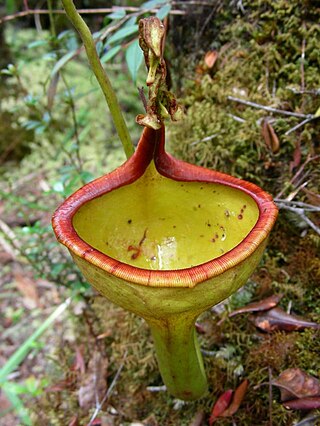
Nepenthes eymae is a tropical pitcher plant endemic to Sulawesi in Indonesia, where it grows at elevations of 1,000–2,000 m (3,300–6,600 ft) above sea level. It is very closely related to N. maxima, from which it differs in its wine glass-shaped upper pitchers.

Nepenthes lamii is a tropical pitcher plant endemic to New Guinea, where it grows at an altitude of up to 3520 m above sea level, higher than any other Nepenthes species. Although once confused with N. vieillardii and previously regarded as conspecific with the closely related N. monticola, it is now recognised as a distinct species.
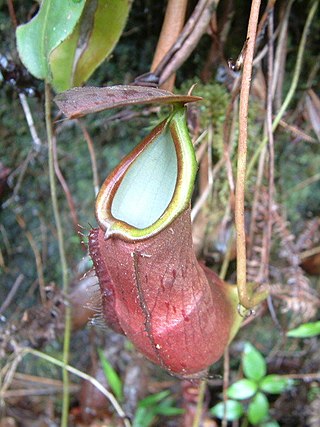
Nepenthes longifolia is a tropical pitcher plant endemic to Sumatra, where it grows at elevations of between 300 and 1100 m above sea level. The specific epithet longifolia, formed from the Latin words longus (long) and folius (leaf), refers to the exceptionally large leaves of this species.

Nepenthes jacquelineae is a tropical pitcher plant endemic to the Indonesian island of Sumatra. Due to its unique pitcher morphology, it is considered to be one of the most spectacular Nepenthes species native to the island.

Nepenthes dubia is a tropical pitcher plant endemic to the Indonesian island of Sumatra, where it grows at an altitude of 1600–2700 m above sea level. The specific epithet dubia is the Latin word for "doubtful".
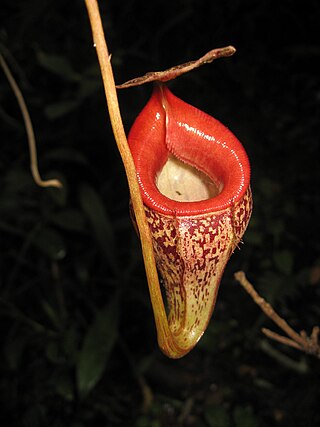
Nepenthes talangensis is a tropical pitcher plant endemic to Sumatra, where it grows in upper montane forest at elevations of 1800–2500 m above sea level.

Nepenthes rigidifolia is a critically endangered tropical pitcher plant endemic to Sumatra, where it grows at elevations of 1000–1600 m above sea level.

Nepenthes izumiae is a tropical pitcher plant endemic to Sumatra, where it grows in montane forest at 1700–1900 m above sea level. It appears to be most closely related to N. lingulata and N. singalana.
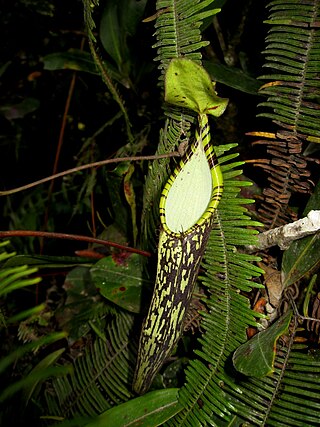
Nepenthes spectabilis is a tropical pitcher plant endemic to Sumatra, where it grows at elevations of between 1400 and 2200 m above sea level. The specific epithet spectabilis is Latin for "visible" or "notable".

Nepenthes jamban is a tropical pitcher plant endemic to northern Sumatra. The specific epithet jamban is the Indonesian word for "toilet" and refers to the shape of the pitchers.

Nepenthes lingulata is a tropical pitcher plant endemic to northern Sumatra. The species is characterised by the highly developed appendage present on the underside of the lid. The specific epithet lingulata is derived from the Latin word lingula, meaning "small tongue", and refers to this unique morphological feature.
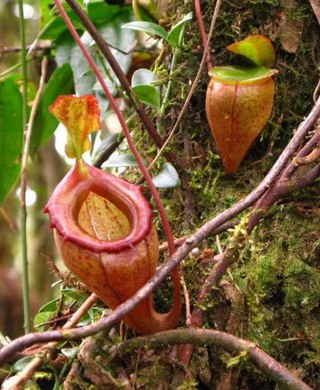
Nepenthes flava is a tropical pitcher plant endemic to northern Sumatra, where it grows in montane forest at 1800–2200 m above sea level.

Nepenthes micramphora is a tropical pitcher plant known only from Mount Hamiguitan on the island of Mindanao in the Philippines. It is a highland plant growing at elevations of 1100–1635 m.

Nepenthes andamana is a tropical pitcher plant endemic to Phang Nga Province, Thailand, where it grows near sea level in coastal savannah and grassland. It is thought to be most closely related to N. suratensis.
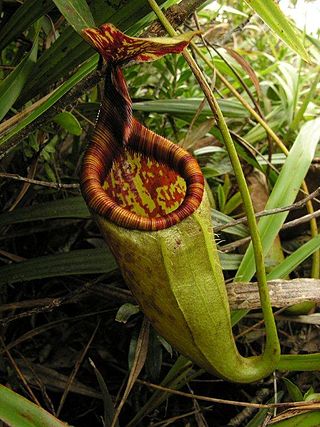
Nepenthes gantungensis is a tropical pitcher plant known from a single peak on the Philippine island of Palawan, where it grows at elevations of 1600–1784 m above sea level.

Nepenthes leonardoi is a tropical pitcher plant known from a single locality in central Palawan, the Philippines. It is closely allied to several other Palawan endemics, including N. deaniana, N. gantungensis, and N. mira. The traps of this species reach at least 24 cm in height. Some specimens are noted for producing very dark, almost black, upper pitchers.
Nepenthes ulukaliana is a tropical pitcher plant endemic to the southern Titiwangsa Range in Peninsular Malaysia. Nepenthes ulukaliana was compared to Nepenthes macfarlanei however, it exhibits several distinctions which include pitchers adorned with a dense covering of filamentous lid hairs measuring less than 1 mm long. Also, the lower pitchers of N. ulukaliana have an amphora-shaped to urceolate form. Furthermore, the peristome of N. ulukaliana is planar at the front, with a well-defined column that emerges abruptly and perpendicularly at the rear.
Nepenthes limiana is a tropical pitcher plant endemic to the northern Titiwangsa Range in Peninsular Malaysia. Nepenthes limiana was compared to Nepenthes sericea and Nepenthes sanguinea. The species differs from N. sericea by its upper pitchers being narrowly cylindrical which has an infundibular base with a pitcher hip on the lower part as compared to the wholly infundibular pitcher with a pitcher hip just below the mouth or pitchers that are basally infundibular turning cylindrical to slightly infundibular above the medial hip in N. sericea. Additionally, the narrowly oblanceolate to almost linear laminae that are slightly decurrent and the proportionally wider and bulbous peristome of the lower pitchers which are often flared and crenellated characterize this species from the sessile and oblanceolate to obovate-oblong laminae and the proportionally thinner peristome that are expanded near column only and not crenellated in N. sericea.

















